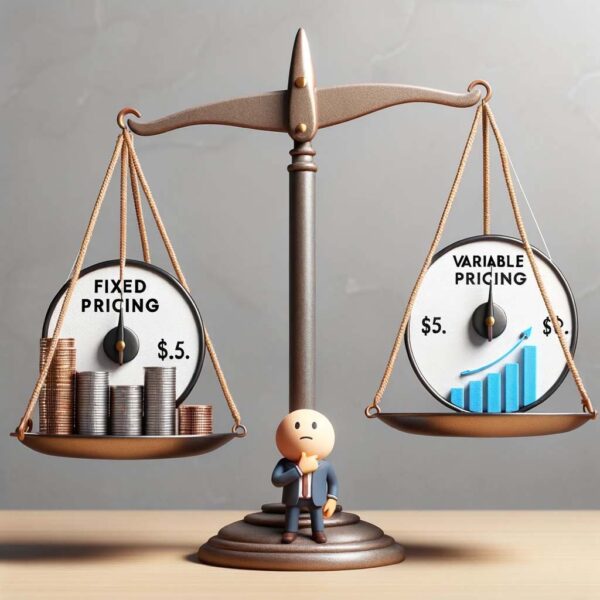
Introduction To 3PL Fixed vs. Variable Pricing Models
Ecommerce is booming, with more and more sellers leveraging platforms like Amazon to reach customers. But operating your own fulfillment and logistics can be complex, time-consuming, and expensive. That’s why many sellers turn to third-party logistics (3PL) providers to handle warehousing, inventory management, order processing, and shipping.
However, not all 3PLs are created equal when it comes to pricing models. Some offer fixed pricing, while others use variable pricing models. Understanding the differences is key for ecommerce sellers looking to maximize profits.
In this article, we’ll break down Amazon 3PL pricing models, including:
- Fixed vs. variable pricing structures
- Typical costs like storage, picking, and delivery
- Amazon FBA’s unique “fixed pricing profit sharing” approach
- Tips for optimizing your 3PL costs on Amazon
Whether you currently use FBA or are considering switching to a 3PL provider, you need to understand the pricing implications. Choosing the right model for your business goals and needs can significantly impact your bottom line.
Looking for a quick answer about the differences between the two?
In Amazon’s third-party logistics (3PL), you’ll find two main pricing types: Fixed and Variable.
Fixed Pricing means you pay the same fees every month, making budgeting simple.
Variable Pricing changes based on how much you use the service, offering savings in slower months but making costs less predictable.
Knowing the difference can help you save money and pick the best option for your business.
Looking for a 3PL Company for your Amazon Product or Ecommerce Business?
Table of Contents
Fixed Pricing Model
Fixed pricing refers to a model where the fees charged by a 3PL provider remain consistent, regardless of order volumes or services rendered. Some examples of common fixed pricing fees include:
Monthly storage fees: A fixed rate to hold your inventory in the warehouse, typically per pallet or cubic foot.
Account setup/management fees: One-time or monthly fixed costs to establish and maintain your 3PL account.
Pick and pack charges: A flat rate per order picked and packaged, not based on number of items.
Shipping minimums: A fixed monthly minimum cost for shipping services.
The main advantage of fixed 3PL pricing is predictability. It makes budgeting and forecasting much simpler when fees don’t fluctuate. You know exactly what to expect each month. This can be reassuring and allows you to easily pass costs onto customers.
However, fixed pricing also comes with some downsides. The rates usually include higher profit margins for 3PLs. And there’s no incentive for them to improve efficiency, since your pricing won’t change. You also lose flexibility, as volumes increase or decrease.

Variable Pricing Model
In contrast to fixed rates, variable pricing fluctuates based on factors like order volume, warehouse utilization, and labor costs. Fees are directly tied to usage and performance. Some examples of variable 3PL costs:
Storage fees based on average weekly cubic footage used rather than fixed monthly
Pick and pack rates per unit, not per order
Labor costs based on hourly wages and time tracked
Shipping tied to carrier discounts and volume rates
The benefit of variable pricing is that you only pay for what you actually use. If business is slower one month, your costs go down. It provides built-in incentives for efficiency – if the 3PL implements technology or processes to save on labor or materials, for example, you would share in those savings.
However, the downside is that costs become less predictable month-to-month. Forecasting and budgeting is more difficult without fixed rates. There is also often a lack of transparency, as utilization rates and labor hours must be tracked and shared.

Amazon FBA Pricing
Amazon’s Fulfillment by Amazon (FBA) pricing model is unique compared to other 3PL providers. Sellers pay Amazon both fixed and variable fees:
Monthly subscription fee (fixed)
Per item referral fee when items sell (variable)
Fulfillment fees per item for storage, picking, and shipping (variable)
Amazon also takes a percentage of each product sale as profit sharing.
This can potentially offer simplicity and scale through Amazon’s infrastructure. But sellers have less control or flexibility compared to a standalone 3PL provider. And Amazon’s pricing and profit splits may cut into margins, especially during peak sales periods.
Key Amazon 3PL Cost Considerations
Beyond fixed vs. variable models, some key costs to understand when budgeting for an Amazon 3PL include:
-
Receiving/intake when shipments arrive at the warehouse
-
Storage utilization rates and inventory handling
-
Pick and pack costs per unit, which can vary by size and weight
-
Shipping rates, which fluctuate based on carrier and discounts
-
Any additional services like bundling, kitting, or gift wrapping
It’s important to pay attention to every cost element, not just base fees. Small charges can add up quickly. Make sure you understand seasonality and peak impacts as well.
Fixed vs. Variable Pricing: Key Differences
In summary, the core difference between fixed and variable 3PL pricing comes down to predictability vs. flexibility:
Fixed pricing allows for stable budgeting but lacks efficiency incentives.
Variable pricing fluctuates but offers usage-based savings.
Consider your risk tolerance, order volatility, and growth plans. Variable pricing makes sense for higher volume, mature businesses, while fixed rates help limit risk for newer sellers.

Tips for Optimizing Amazon 3PL Costs
To optimize your 3PL strategy on Amazon:
Select the pricing model that aligns with your business needs and goals
Negotiate rates and minimums to increase transparency and cost control
Leverage technology and automation to drive efficiency where possible
Forecast inventory/sales intelligently to manage storage and labor costs
Understand and budget for hidden fees and peak season surcharges
Choosing the right 3PL pricing model requires careful evaluation of tradeoffs. But identifying the best fit for your business can yield significant fulfillment savings and higher profitability over the long-term.
FAQ
A 3PL is a company that handles logistics services like warehousing, inventory management, order fulfillment, and shipping for sellers. Using a 3PL can help ecommerce businesses scale their operations.
The two main pricing models are fixed pricing and variable pricing:
- Fixed pricing means rates stay the same regardless of volume.
- Variable pricing fluctuates based on factors like usage and performance.
Amazon uses a “fixed pricing profit sharing” model. Sellers pay monthly fees, per item referral fees, and variable fulfillment fees. Amazon also takes a percentage of sales as profit sharing.
Common costs include storage fees, account setup/management, pick and pack charges per unit, shipping rates, receiving/intake fees, and any additional services.
Fixed pricing allows for predictable budgeting but lacks flexibility. Variable pricing fluctuates but offers usage-based savings and efficiency incentives.
Choose the right pricing model for your business, leverage technology, forecast intelligently, negotiate rates, and understand potential hidden fees.
Evaluate your order volumes, growth plans, risk tolerance, and need for budget predictability vs. flexibility. Assess pros and cons for your specific situation.







